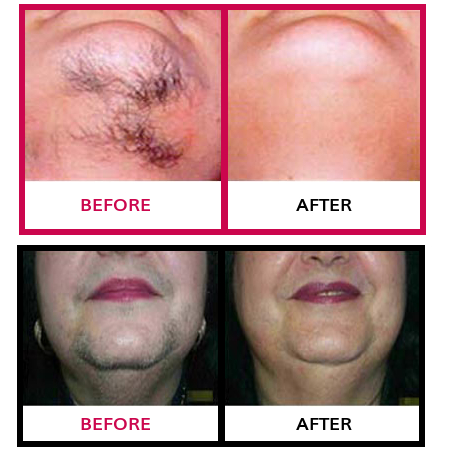Electrolysis Hair Removal
1 Hour
30min
20min
15min
An Introduction to Electrolysis Hair Removal
For any client considering treatment, or merely wishing for information, we carry out a free consultation. It is carried out in private and without obligation by highly trained operators. All staff are either members of the professional bodies listed on the website , or have obtained City and Guilds or B.T.E.C. National qualifications
Deciding to make an appointment is not easy. Clients coming from various backgrounds are sometimes frightened, and unfortunately, cannot share their embarrassment with anyone. In todays society. we are able to talk about many topics, but as yet, unwanted hair is not one of them. Clients can suffer great frustration, after trying temporary hair removal methods, and finding that the hair grows back just as strongly, and in most cases, returns even more strongly than before. We hope you will find the information useful, and be encouraged to embark on what the medical profession sees as the only long lasting treatment.
What is electrolysis?
Electrolysis is the permanent removal of unwanted hair. We use Diathermy epilation is the permanent removal of unwanted hair using a short-wave diathermy current. This current creates heat, which is delivered to the hair at the root. The heat dries up all the moisture, living cells and blood supply thus destroying it.

How does electrolysis work?
The dermal papilla cells at the base of the follicle, which supply the hair with nutrients for growth are destroyed by the application of heat, taking just a few seconds. But removal of hair by electrolysis is not achieved in just a single treatment, the hairs removed grow back finer and weaker, until they finally fail to grow back. It is therefore a progressive treatment, and clients must think carefully before embarking on a course of electrolysis. It will need commitment to improve the chances of success. However, the rewards can be seen in people who have skin which can be seen to be almost free of hairs – and who have found an increase in their personal confidence.
Read More Superfluous hair affects some seventy percent of all women in Great Britain at the present time. It does not affect men, simply because there is not such a social stigma attached to men having body and facial hair. This is the main reason why many women feel embarrassed about asking for help with the problem, but we try to be as understanding as possible, having had many years experience in dealing with such matters. You should note however that in the event of something which may be inappropriate to you receiving electrolysis , e.g. a heart pacemaker, we will not treat you without a note of consent from your consultant. There are two main factors which cause an accelerated hair growth. The first stems from an increased blood supply, which usually results from irritation to the local area of skin affected, e.g. waxing, plucking and friction. Trauma to the area, such as scarring caused by cuts etc, may also cause an increased blood supply and stimulate hair growth. The second major cause is hormone stimulation. Some people are more sensitive to this, because it is a part of their genetic makeup which governs everything about them. Hair growth can also be caused by routine changes in the body’s hormones, e.g. at pregnancy, menopause, and puberty. Growths may also occur when the system of endocrine glands which produce hormones is affected. Hormonal changes and conditions account for many problems besides unwanted hair. The cause can be Polycystic Ovary Syndrome (PCOS), an underlying medical condition. You may want to see an endocrinologist to get a proper diagnosis and treatment. As Electrologists we cannot diagnose, but can ask you the questions that will help you have further discussions with your doctor. Regardless of the cause, we can permanently remove the unwanted hair. The length of each treatment, and duration of the course is impossible to predict, as each client is an individual. The severity of the hair growth, how long the growth has been established, the cause of the unwanted hair, and the client’s availability for regular treatments are all factors taken into account in our free and thorough consultation. The client will be advised as to her approximate treatment needs. After electro-epilation a protective anti-bacterial cream is applied and is best left alone until the following day allowing the skin to cool down and settle naturally. Try to avoid touching the area We offer a 1 hour course which can be split into 1/2 hours, 20 mins or 15 minute sessions which gives a good saving , or you can pay individually. Everyone is welcome.Who is affected by superfluous hair growth?
What are the causes of superfluous hair?
Prolonged mental and physical stress, and certain types of hormone therapy and medication can also be factors contributing to an unwanted growth. There is also some evidence to suggest that the tendency to grow unwanted hair can be passed on from generation to generation. This is known as the hereditary factor.How long will a course of treatment take?
After Care
Home Care to remember:
Make-up should NOT be applied immediately after as infection can result
Do NOT use hot water on the face for 24
hours
Do NOT sun bathe or use sunbeds for the next 24 hours
Do NOT have a sauna or any form of heat
treatment
An antiseptic cream should be applied for 3 days after the treatment to promote good skin healing
